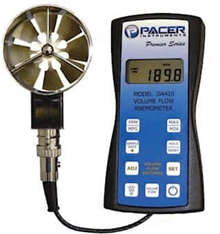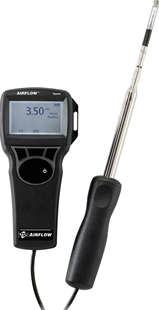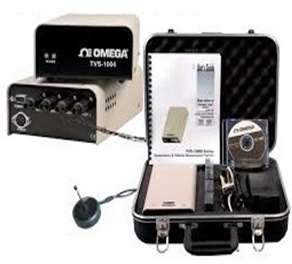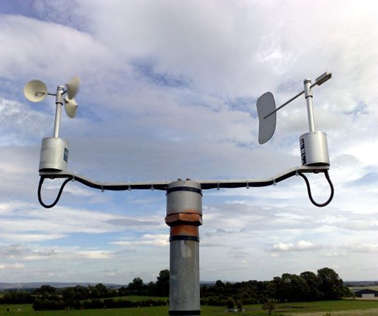- An anemometer is a device used to measure the velocity or speed of air (gases) in both confined and unconfined flows, such as atmospheric wind and airflow in ducts. Anemometers use changes in a fluid’s physical properties or their impact on a mechanical device put into the flow to determine the air velocity.
- The knot (nautical mile per hour = 0.51 m sec-1 = 1.15 mph) is the commonly used unit of wind speed. Wind direction is given from the location where the wind is blowing and is measured relative to true north (not magnetic north). A wind blows from the east, or 90 degrees, from the south, or 180 degrees, and from the west, or 270 degrees, from the east.

- Normal wind speed increases with height above the surface of the earth and is greatly influenced by things like the terrain’s roughness and the existence of nearby structures, trees, and other obstructions.
- The best exposure for measuring wind is over flat, uniformly rough terrain with no significant obstructions within 300 meters of the tower. In reality, only a few of the observing network’s sites precisely match this condition for all incident wind directions, although the majority are fairly typical of an open site.
- There are numerous anemometer models available for accurately determining wind and air velocity. Vane anemometers, thermal anemometers, thermal anemometers with velocity/temperature profiling, and cup anemometers are the four most common models.
Anemometers for weather stations
- The velocity is measured by the cup anemometer (found in weather stations) in a plane perpendicular to the axis of its rotating cups. Only the wind component that is parallel to the ground will be measured if the cup anemometer is positioned with the shaft perpendicular to the horizontal. Vane anemometers are one example of an anemometer whose tip is employed with the vector of total velocity in mind. It is crucial to know where an anemometer should be placed and what percentage of the total velocity its measurement reflects before utilizing one.
Vane Anemometer
- The vane or propeller classes of rotating mechanical velocity anemometers can be used to categorize them. The axis of rotation for an anemometer of this type must be horizontal and parallel to the wind’s direction. The axis must adjust to the wind’s shifting directions in open areas. Wind vanes, also known as air meters, are used in situations where the direction of the air motion is constantly the same, such as in the ventilating shafts of mines and buildings, for example, and produce very excellent results. Vane anemometers can be purchased with extra features including the capacity to log data and measure temperature, humidity, and dew point.

Thermal Anemometer
- A very thin wire (on the order of several micrometers) or other element is heated to a temperature above the surrounding air in thermal anemometers. A cooling effect is produced by air passing across. A correlation between the resistance of the wire and the flow velocity can be found because the electrical resistance of most metals is temperature-dependent (tungsten is a preferred metal for hot wires).

Thermal Anemometers with Velocity / Temperature Profiling
- The smallest sensor is used in thermal anemometer profiling systems. Temperature and velocity are both measured by the sensors. The user can profile flow parameters in the program and do graphical data analysis thanks to the multi-point data-logging system. These are frequently employed in wind tunnels for the examination of circuit boards and heat sinks.

Cup Anemometer
- The cup anemometer is a straightforward sort of anemometer. It was made up of three or four horizontal arms with three or four hemispherical cups set on each end. The horizontal arms were mounted on a vertical shaft at right angles to one another. Any horizontal airflow that passed over the cups caused them to turn in a way that was inversely proportional to the wind speed. Thus, the average wind speed for a wide range of speeds was obtained by counting the rotations of the cups over a predetermined amount of time.
- On an anemometer with four cups, it is simple to notice that the wind always blows on the back of the cup on the opposite end of the cross since the cups are situated symmetrically on the ends of the arms.
- A cup anemometer, which typically consists of three or four conical or hemispherical cups set symmetrically around a vertical spindle, is used to measure wind speed. The spindle rotates as a result of the wind blowing into the cups. In common instruments, the design of the cups makes it so that, roughly speaking, the rate of rotation is proportionate to the wind speed.
- A vane that has a slender horizontal arm, a vertical flat plate with its edge facing the wind, and a balance weight that also acts as a pointer at the other end to measure the direction of the wind. The arm is supported by a vertical spindle that is positioned on bearings and may move freely in the wind. At the top of a 10 m mast, the anemometer and wind vane are individually fastened to a horizontal supporting arm.

Applications of Anemometer Kit
- Different uses are depending on the different situations.
- It is used to measure the speed of the wind.
- It is used to measure the velocity of the wind.
- It is used to measure the pressure of the wind.
- It is used to check the quality of the wind.
- It is used to check the direction of the wind.
- It is used to check the rate of flow of wind.
- It is used to read the pattern of weather.
- It is used at the weather station from the frigid Arctic to warm equatorial regions.
- It is used by the engineers to make the vehicle more aerodynamic.
